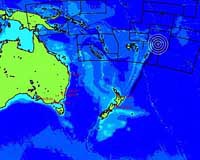| . |  |
. |
Paris (AFP) Sept 30, 2009 A once-exotic word that has now entered everyday use as a term tinged with fear, a tsunami refers to a shock of water propagated through the sea, usually after an undersea quake. A section of seabed is thrust up or driven down by movement of Earth's crust. The rift displaces vast quantities of water that move as waves, able to span enormous distances and sometimes with the speed of a jet plane. The 8.0-magnitude quake that occurred under the Pacific Ocean near the Samoan islands on Tuesday unleashed waves estimated by witnesses and officials to reach 3.0 and 7.5 metres (10 and 24.3 feet) high. According to a still-incomplete toll, 113 people were killed. When tsunamis approach a coastline, the shelving of the sea floor causes them to slow down -- but also gain in height. To those on the shore, the first sign of something amiss is an eerie retreat of the sea, which is followed by the arrival of exceptional waves. "The sea was driven back, and its waters flowed away to such an extent that the deep sea bed was laid bare and many kinds of sea creatures could be seen," wrote Roman historian Ammianus Marcellus, awed at a tsunami that struck the then-thriving port of Alexandria in 365 AD. "Huge masses of water flowed back when least expected, and now overwhelmed and killed many thousands of people.... Some great ships were hurled by the fury of the waves onto the rooftops, and others were thrown up to two miles (three kilometres) from the shore." Several factors determine the height and destructiveness of a tsunami. They include the size of the quake, the volume of displaced water, the topography of the sea floor as the waves race to the coast, and whether there are natural obstacles that dampen the shock. Destruction of protective mangroves and coral reefs, and the building of homes or hotels on exposed beaches, are fingered as leading causes of high death tolls from tsunamis. Large quakes are the main drivers of tsunamis, but the phenomenon can also be sparked by other cataclysmic events, such as volcanic eruptions and even landslides. In 1883, a volcano shattered the Pacific island of Krakatoa, causing a blast so loud that it could be heard 4,500 kilometres (2,800 miles) away, followed by a tsunami that killed some 30,000 people. The great tsunami of December 2004 in the Indian Ocean was caused by a monstrous 9.1-magnitude earthquake off the Indonesian island of Sumatra. It released the energy of 23,000 Hiroshima-type atomic bombs, according to the US Geological Survey (USGS). Some 220,000 people in 11 nations were killed, many of them thousands of kilometres from the epicentre. The Pacific Ocean is particularly prone to earthquakes and therefore to tsunamis -- indeed the word "tsunami" comes from the Japanese words for "harbour" and "wave". But recent research has found that, over the millennia, tsunamis have occurred in many parts of the world, including the Atlantic and Mediterranean. A global monitoring network, overseen by the UN, has been set in place to alert areas at risk.
Share This Article With Planet Earth
Related Links Bringing Order To A World Of Disasters When the Earth Quakes A world of storm and tempest
 'Sea of devastation': Samoans flee deadly tsunami
'Sea of devastation': Samoans flee deadly tsunamiApia (AFP) Sept 29, 2009 Witnesses told of scenes of panic and confusion Tuesday after a major earthquake hurled giant waves at the islands of Samoa, smashing buildings, throwing cars and hurling boats ashore. Young men banged gas canisters like "church bells" to bring thousands of frightened people streaming to higher ground as the disaster unfolded in coastal towns below. Foreign tourists and residents of the ... read more |
|
| The content herein, unless otherwise known to be public domain, are Copyright 1995-2009 - SpaceDaily. AFP and UPI Wire Stories are copyright Agence France-Presse and United Press International. ESA Portal Reports are copyright European Space Agency. All NASA sourced material is public domain. Additional copyrights may apply in whole or part to other bona fide parties. Advertising does not imply endorsement,agreement or approval of any opinions, statements or information provided by SpaceDaily on any Web page published or hosted by SpaceDaily. Privacy Statement |